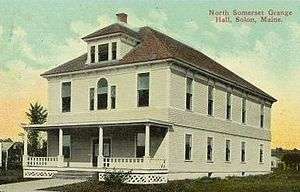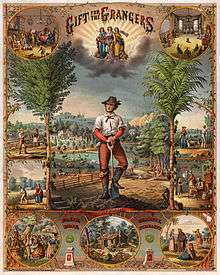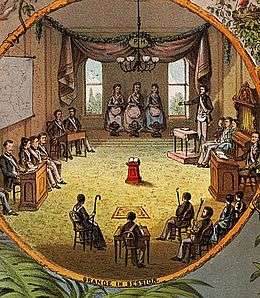National Grange of the Order of Patrons of Husbandry

The Grange, officially referred to as The National Grange of the Order of Patrons of Husbandry, is a fraternal organization in the United States that encourages families to band together to promote the economic and political well-being of the community and agriculture. The Grange, founded after the Civil War in 1867, is the oldest American agricultural advocacy group with a national scope. Major accomplishments credited to Grange advocacy include passage of the Granger Laws and the establishment of rural free mail delivery.
In 2005, the Grange had a membership of 160,000, with organizations in 2,100 communities in 36 states. It is headquartered in Washington, D.C., in a building built by the organization in 1960. Many rural communities in the United States still have a Grange Hall and local Granges still serve as a center of rural life for many farming communities.
History

President Andrew Johnson commissioned Oliver Kelley to go to the Southern states and to collect data to improve Southern agricultural conditions. In the South, poor farmers bore the brunt of the Civil War and were suspicious of Northerners like Kelley. Kelley found he was able to overcome these sectional differences as a Mason. With Southern Masons as guides, he toured the war-torn countryside in the South and was appalled by the outdated farming practices. He saw the need for an organization that would bring people from the North and South together in a spirit of mutual cooperation and, after many letters and consultations with the other founders, the Grange was born.[1] The first Grange was Grange #1, founded in 1868 in Fredonia, New York.[2] Seven men and one woman co-founded the Grange: Oliver Hudson Kelley, William Saunders, Francis M. McDowell, John Trimble, Aaron B. Grosh, John R. Thompson, William M. Ireland, and Caroline Hall.[3]
Paid agents organized local Granges and membership in the Grange increased dramatically from 1873 (200,000) to 1875 (858,050). Many of the state and local granges adopted non-partisan political resolutions, especially regarding the regulation of railroad transportation costs. The organization was unusual at this time because women and any teen old enough to draw a plow were encouraged to participate. The importance of women was reinforced by requiring that four of the elected positions could be held only by women.[4]

Rapid growth infused the national organization with money from dues, and many local granges established consumer cooperatives, initially supplied by the wholesaler Aaron Montgomery Ward. Poor fiscal management, combined with organizational difficulties resulting from rapid growth, led to a massive decline in membership. By the turn of the 20th century, the Grange rebounded and membership stabilized.
The Granger movement succeeded in regulating the railroads and grain warehouses. The births of the Cooperative Extension Service, Rural Free Delivery, and the Farm Credit System were due largely to Grange lobbying. The peak of their political power was marked by their success in Munn v. Illinois (1877), which held that grain warehouses were a "private utility in the public interest," and so could be regulated by public law. However this achievement was overturned later by the Supreme Court in Wabash v. Illinois (1886).[5]
Other significant Grange causes included temperance, the direct election of Senators and women's suffrage. (Susan B. Anthony's last public appearance was at the National Grange Convention in 1903.) [6] During the Progressive Era of the 1890s to the 1920s political parties took up Grange causes. As a consequence, local Granges focused more on community service, although the State and National Granges remain a political force.
In the 20th and 21st centuries, the position of the Grange as a respected organization in the United States was indicated by a membership that included Presidents Franklin D. Roosevelt and Harry S. Truman, artist Norman Rockwell, businessman Frederick Hinde Zimmerman, and Nirvana bassist Krist Novoselic.[6] The monument to the founding of the Grange is the only private monument on the National Mall in Washington, D.C.[7]
Grange membership has declined considerably as the percentage of American farmers has fallen from a third of the population in the early 20th century to less than two percent today. Between 1992 and 2007, the number of Grange members fell by 40%.[8] Washington has the largest membership of any state, at approximately 13,000.
Today

As of 2013 the Grange continues to press for the causes of farmers, including issues of free trade and farm policy. In its 2006 Journal of Proceedings, the organization's report on its annual convention, the organization lays out its mission and how it works towards achieving it through fellowship, service, and legislation:
The Grange provides opportunities for individuals and families to develop to their highest potential in order to build stronger communities and states, as well as a stronger nation.
As a non-partisan organization, the Grange supports only policies, never political parties or candidates. Although the Grange was originally founded to serve the interests of farmers, because of the shrinking farm population the Grange has begun to broaden its range to include a wide variety of issues, and anyone is welcome to join the Grange.
The Junior Grange is open to children 5-14. Regular Grange membership is open to anyone age 14 or older. The Grange Youth, a group within the Grange, consists of members 13 1/2-35.
In 2013, the Grange signed on to a letter to Congress calling for the doubling of legal immigration and legalization for illegal immigrants currently in the United States. However, this position has been revised, and the Grange now strongly opposes illegal immigration, giving amnesty to illegal aliens, or increasing the number of persons allowed to immigrate. Instead, the Grange supports temporary agricultural worker programs, combined with strict enforcement of immigration laws [9]
Rituals and ceremonies

When the Grange first began in 1867, it borrowed some of its rituals and symbols from Freemasonry, including secret meetings, oaths and special passwords.[10] It also copied ideas from Greek and Roman mythology and the Bible. Small, ceremonial farm tools are often displayed at Grange meetings. Elected officers are in charge of opening and closing each meeting. There are seven degrees of Grange membership; the ceremony of each degree relates to the seasons and various symbols and principles.[11]
During the last few decades, the Grange has moved toward public meetings and no longer meets in secret. Though the secret meetings do not occur, the Grange still acknowledges its rich history and practices some traditions.
Organization
The Grange is a hierarchical organization ranging from local communities to the National Grange organization. At the local level are community Granges, otherwise known as subordinate Granges. All members are affiliated with at least one subordinate. In most states, multiple subordinate Granges are grouped together to form Pomona Granges. Typically, Pomona Granges are made up of all the subordinates in a county. Next in the order come State Granges, which is where the Grange begins to be especially active in the political process. State Masters (Presidents) are responsible for supervising the administration of Subordinate and Pomona Granges. Together, thirty-five State Granges, as well as Potomac Grange #1 in Washington, D.C., form the National Grange. The National Grange represents the interests of most Grangers in lobbying activities similar to the state, but on a much larger scale. In addition, the National Grange oversees the Grange ritual. The Grange is a grassroots organization; virtually all policy originates at the subordinate level.
The motto of the Grange is In necessariis unitas, in dubiis libertas, in omnibus caritas ("In essentials, unity; in non-essentials, liberty; in all things, charity"). Indeed, the word "grange" comes from a Latin word for grain, and is related to a "granary" or, generically, a farm.
See also
References
- ↑ William D. Barnes, "Oliver Hudson Kelley and the Genesis of the Grange: A Reappraisal," Agricultural History (1967) 41:229–242
- ↑ D. Sven. Nordin, Rich Harvest: A History of the Grange, 1867–1900 (1974) ch 1
- ↑ Ezra Slocum Carr (1875). The Patrons of husbandry on the Pacific coast: Being a complete history of the origin, condition and progress of agriculture in different parts of the world; of the origin and growth of the order of Patrons, with a general and special grange directory, and full list of charter members of the subordinate granges of California. Also, of the foes of the farmers, or monopolies of land, water, transportation and education; of a protective tariff, currency and banking. A. L. Bancroft. p. 105.
- ↑ Adam D. Sheingate (2003). The Rise of the Agricultural Welfare State: Institutions and Interest Group Power in the United States, France, and Japan. Princeton U.P. p. 60.
- ↑ David B. Danbom (2006). Born in the Country: A History of Rural America. Johns Hopkins U.P. pp. 154–6.
- 1 2 Washington State Grange (official site)
- ↑ The National Grange of the Order of Patrons of Husbandry
- ↑ Krishnan, Sonia (2007-07-29). "Beyond Potlucks". The Seattle Times.
In the past 15 years, Grange membership has fallen nearly 40 percent to 240,000 people. These days, fewer than 2 percent of Americans farm.
- ↑ http://www.nationalgrange.org/immigration-issue-brief/
- ↑ Jay Kinney (2009). The Masonic Myth: Unlocking the Truth About the Symbols, the Secret Rites, and the History of Freemasonry. HarperCollins. p. 70.
- ↑ Dennis Sven Nordin (2006). Rich Harvest: A History of the Grange, 1867-1900. U. Press of Mississippi. p. 10.
Further reading
- Atkeson, Thomas Clark. Semi-centennial history of the Patrons of husbandry (1916) 364pp full text online
- Barnes, William D. "Oliver Hudson Kelley and the Genesis of the Grange: A Reappraisal," Agricultural History, Vol. 41, No. 3 (Jul., 1967), pp. 229–242 in JSTOR
- Buck, Solon Justus. The Granger movement: A Study of Agricultural Organization and its Political, Economic, and Social Manifestations, 1870-1880 (1913) 384pp; full text online; excellent older history (newer is Nordin (1974)
- Ferguson, James S. "The Grange and Farmer Education in Mississippi," Journal of Southern History, Vol. 8, No. 4 (Nov., 1942), pp. 497–512 in JSTOR
- Gardner, Charles M. The Grange: Friend of the Farmer (1949) 531pp.
- Hirsch, Arthur H. "Efforts of the Grange in the Middle West to Control the Price of Farm Machinery, 1870-1880," Mississippi Valley Historical Review, Vol. 15, No. 4 (Mar., 1929), pp. 473–496 in JSTOR
- Howard, David H. People, Pride, and Progress: 125 Years of the Grange in America (1992) 335pp.
- Lownsbrough, John. The Privileged Few. The Grange and its People in Nineteenth Century Ontario (1980)
- Marti, Donald B. Women of the Grange: Mutuality and Sisterhood in Rural America, 1866-1920 (1991)
- Nordin, D. Sven. Rich Harvest: A History of the Grange, 1867–1900 (1974), 273pp excerpt and text search
- Saloutos, Theodore. "The Grange in the South, 1870-1877," Journal of Southern History, Vol. 19, No. 4 (Nov., 1953), pp. 473–487 in JSTOR
- Schneiberg, Marc et al. "Social Movements and Organizational Form: Cooperative Alternatives to Corporations in the American Insurance, Dairy, and Grain Industries," American Sociological Review 2008 73(4): 635-667, theoretical essay
- Schell, Herbert S. "The Grange and the Credit Problem in Dakota Territory," Agricultural History, Vol. 10, No. 2 (Apr., 1936), pp. 59–83 in JSTOR
- Tontz, Robert L. "Memberships of General Farmers' Organizations, United States, 1874-1960," Agricultural History, Vol. 38, No. 3 (Jul., 1964), pp. 143–156 in JSTOR statistical tables showing membership in the Grange and other farm organizations by date and state and region
- Woods, Thomas A. ''Knights of the Plow: Oliver H. Kelley and the Origins of the Grange in Republican Ideology (2002)
Primary sources
- Goss, Albert S. "Legislative Program of the National Grange," Journal of Farm Economics, Vol. 29, No. 1, Proceedings Number (Feb., 1947), pp. 52–63 by Grange leader
- Kelley, Oliver Hudson. Origin and progress of the order of the Patrons of Husbandry in the United States (1875) 441pp full text online
- full texts of primary sources on Grange
External links
- Official Website of the National Grange of the Order of Patrons of Husbandry
- "A Short History of the Order of Patrons of Husbandry, also known as the National Grange," by Charles P. Gilliam
- Background, History, Ritual and Emblems of the Grange
- Encyclopedia of Arkansas History & Culture
-
 Texts on Wikisource:
Texts on Wikisource:
- "Husbandry, Patrons of". Collier's New Encyclopedia. 1921.
- "Grangers". Encyclopedia Americana. 1920.
- "Grange". New International Encyclopedia. 1905.
- "Husbandry, Patrons of". The American Cyclopædia. 1879.